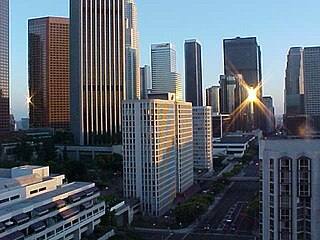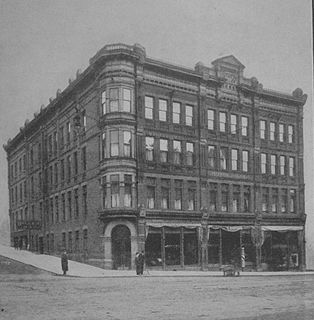Related Research Articles
A skid row or skid road is an impoverished area, typically urban, in English-speaking North America whose inhabitants are mostly poor people "on the skids". This specifically refers to poor or homeless, either considered disreputable, downtrodden or forgotten by society. A skid row may be anything from an impoverished urban district to a red-light district to a gathering area for homeless people and drug addicts. In general, skid row areas are inhabited or frequented by individuals marginalized by poverty and also drug addicts. Urban areas considered skid rows are marked by high vagrancy, dilapidated buildings, and drug dens, as well as other features of urban blight. Used figuratively, the phrase may indicate the state of a poor person's life.

The Columbia Center, formerly named the Bank of America Tower and Columbia Seafirst Center, is a skyscraper in downtown Seattle, Washington, United States. The 76-story structure is the tallest building in Seattle and the state of Washington, reaching a height of 933 ft (284 m). At the time of its completion, the Columbia Center was the tallest structure on the West Coast; as of 2017 it is the fourth-tallest, behind buildings in Los Angeles and San Francisco.

Downtown Los Angeles (DTLA) is the central business district of Los Angeles, California. In addition, it contains a diverse residential area of some 85,000 people, and covers 5.84 sq mi (15.1 km2). A 2013 study found that the district is home to over 500,000 jobs. It is also part of Central Los Angeles.

Climate Pledge Arena is a multi-purpose arena in Seattle, Washington. It is located north of downtown Seattle in the 74-acre (30 ha) entertainment complex known as Seattle Center, the site of the 1962 World's Fair. Originally developed for the exposition, it was bought and converted by the city of Seattle afterwards for entertainment purposes such as concerts, ice shows, circuses, and sporting events. The arena is currently undergoing redevelopment work at an estimated cost of $1.15B; it is expected to open in October 2021 with a capacity of 17,100 for ice hockey and 18,100 for basketball.

Flexcar was a car sharing company based in Seattle, Washington, the oldest and second-largest in the United States, behind Boston-based Zipcar, with which it merged in late 2007.

Transportation in Seattle is largely focused on the automobile like many other cities in western North America; however, the city is just old enough for its layout to reflect the age when railways and trolleys predominated. These older modes of transportation were made for a relatively well-defined downtown area and strong neighborhoods at the end of several former streetcar lines, now mostly bus lines.

The Seattle Underground is a network of underground passageways and basements in the Pioneer Square neighborhood of Seattle, Washington, United States. They were located at ground level when the city was built in the mid-19th century, but fell into disuse after the streets were elevated. In recent decades they have become a tourist attraction, with guided tours taking place around the area.

The Washington State Convention Center (WSCC) is a convention center in Seattle, Washington, United States. It consists of several exhibition halls and meeting rooms in buildings along Pike Street in Downtown Seattle. Part of the complex straddles Interstate 5 and connects with Freeway Park. The convention center was planned in the late 1970s and funded through $90 million in bonds issued by the state legislature.

NBBJ is an American global architecture, planning and design firm with offices in Beijing, Boston, Columbus, Hong Kong, London, Los Angeles, New York, Portland, Pune, San Francisco, Seattle, and Shanghai.

The South Lake Union Streetcar, officially the South Lake Union Line, is a streetcar route in Seattle, Washington, United States, forming part of the Seattle Streetcar system. It travels 1.3 miles (2.1 km) and connects Downtown Seattle to the South Lake Union neighborhood on Westlake Avenue, Terry Avenue, and Valley Street. The South Lake Union Streetcar was the first modern line to operate in Seattle, beginning service on December 12, 2007, two years after a separate heritage streetcar ceased operations.

Hyatt Regency Seattle, also known as 808 Howell Street and 8th & Howell, is a high-rise hotel in the Denny Triangle neighborhood of Seattle, Washington that opened in December 2018. The 45-story hotel, operated by Hyatt, has 1,260 hotel rooms and is the largest in the city. It also has 103,000 square feet (9,600 m2) of meeting and event space, as well as two ballrooms and a lounge.

The State Route 99 tunnel, also known as the Alaskan Way Viaduct replacement tunnel, is a bored highway tunnel in the city of Seattle, Washington, United States. The 2-mile (3.2 km), double-decker tunnel carries a section of State Route 99 (SR 99) under Downtown Seattle from SoDo in the south to South Lake Union in the north.

ZGF Architects LLP (ZGF), formerly Zimmer Gunsul Frasca Partnership, is an American architectural firm with offices in Portland, Oregon; Seattle, Washington; Los Angeles, California; Washington D.C.; New York, New York; and Vancouver, Canada. Founded in 1942, the firm was listed in 2011 as the #4 architectural firm in the United States by Building Design+Construction, and ranked the #9 architectural firm by Architect. In 2016 Architect named ZGF the #1 architecture firm in the country, citing the organization's dedication to sustainability as a major deciding factor. Between the company's five offices in the United States and their office in Canada they employ more than 600 employees.

The Diller Hotel is a former hotel building in downtown Seattle, Washington. In the early 1900s, it was known as one of Seattle's few luxury hotels. This historic building is located at the corner of First Avenue and University Street, across from the Seattle Art Museum, and is one of the few remaining buildings left from the 1890s, a period of reconstruction and commercial development after the area was destroyed by the fire of 1889. The hotel was owned by Leonard Diller (1839–1901) and family and was designed by architect Louis L. Mendel. The building is now home to The Diller Room, a craft cocktail bar housed in the former hotel lobby.
Sonics Arena was a proposed multi-purpose arena to be constructed in the SoDo neighborhood of Seattle, Washington, United States. The arena would have hosted basketball, ice hockey, and concerts. The proposal called for an arena with a capacity of around 19,000 to 20,000 seats. It was part of a larger plan to return the Seattle SuperSonics (NBA) franchise, along with adding a potential National Hockey League (NHL) franchise, to the city of Seattle. The proposal was rejected in favor of redeveloping KeyArena into Climate Pledge Arena.

Bell Street Park is a 1.33-acre (0.54 ha) park, created in 2014 in Seattle, Washington's Belltown neighborhood. Situated in a neighborhood described as a former "hot-spot for low-level crime, drug-dealing and civil disorder", and intended in part to reduce crime rates on the street, the property was transferred from the city's transportation department to Parks and Recreation, and it was redeveloped as a woonerf or mixed-use pedestrian/vehicular traffic area without curbs.
The City of Seattle Landmarks Preservation Board is responsible for designating and preserving structures of historical importance in Seattle, Washington. The board recommends actions to the Seattle City Council, which fashions these into city ordinances with the force of law. The board is part of the city's Department of Neighborhoods.

The Denny Substation is an electrical substation located in the South Lake Union neighborhood of Seattle, Washington, and operated by Seattle City Light. The facility takes up a whole city block along Denny Way and features a community center, interpretive exhibits, a dog park, and public art.
References
- 1 2 "Street Vacation: Explanation of Vacation Proceedings". Los Angeles Bureau of Engineering . Retrieved February 20, 2017.
- 1 2 "Street and Road Vacation Procedures". Municipal Research and Services Center . Retrieved February 20, 2017.
- 1 2 "Street Vacations". Seattle Department of Transportation . Retrieved February 20, 2017.
- ↑ "Easement Vacation and Replats". Alaska Department of Natural Resources . Retrieved February 20, 2017.
- ↑ "Vacating a Street". Portland Bureau of Transportation . Retrieved February 20, 2017.
- ↑ Bishop, Todd (January 12, 2016). "Seattle requires Amazon to allow free speech in future courtyard, amid larger debate over company's impact". GeekWire . Retrieved February 20, 2017.
- ↑ Garbes, Angela (March 30, 2016). "Amazon Is Giving Its Downtown Employees a World of Restaurant Choices—Will the Rest of the City Show Up to Eat?". The Stranger . Retrieved February 20, 2017.
- ↑ Berger, Knute (July 29, 2013). "Whole Feuds". Crosscut.com . Retrieved February 20, 2017.
- ↑ Stiles, Marc (April 9, 2014). "City Council says yes to West Seattle Whole Foods project". Puget Sound Business Journal . Retrieved February 20, 2017.
- ↑ Bhatt, Sanjay (November 9, 2013). "Alley divides the city and downtown hotel developer". The Seattle Times . Retrieved February 20, 2017.
- ↑ Porter, Lynn (October 7, 2016). "Hedreen also planning a new 450-room hotel". Seattle Daily Journal of Commerce . Retrieved February 20, 2017.
- ↑ Baker, Geoff. "Seattle City Council kills sale of street for Sodo arena; Sonics fans despair". The Seattle Times. Retrieved February 20, 2017.
- ↑ "With expansion, Washington State Convention Center agrees to provide more than $80 million in public benefits". The Seattle Times. 2017-10-16. Retrieved 2018-05-22.